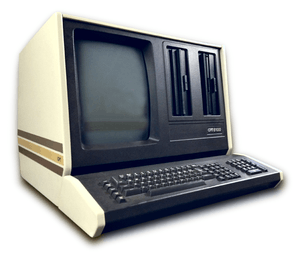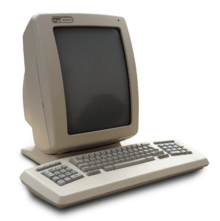CPT Corporation
|
| |
| Traded as | CPTC, National Over the Counter |
|---|---|
| Industry | Word Processing |
| Fate | Discontinued |
| Founded | 1971 |
| Founder | Dean Scheff |
| Headquarters | Factories in USA and Ireland, Eden Prairie, Minnesota, United States |
Area served | World wide |
| Products | Stand-alone word processing machines |
| Revenue | $200,000,000 annually max |
Number of employees | 2000 |
CPT Corporation was founded in 1971 by Dean Scheff in Minneapolis, Minnesota, with co-founders James Wienhold and Richard Eichhorn.[1] CPT first designed, manufactured, and marketed the CPT 4200, a dual-cassette-tape machine that controlled a modified IBM Selectric typewriter to support text editing and word processing.
The CPT 4200 was followed in 1976 by the CPT VM (Visual Memory), a partial-page display-screen dual-cassette-tape unit, and shortly thereafter by the CPT 8000, a full-page display dual-diskette desktop microcomputer that drove stand-alone daisy wheel printers.
Subsequent products included (1) variants on the 8000 series; (2) the CPT 6000 series, which had a lower capacity, smaller screen, and was less expensive; (3) the CPT 9000 series, which had a larger capacity and could run IBM personal computer software; (4) the CPT Phoenix series, which had a graphical capabilities; (5) CPT PT, a software-only reduced version that ran on IBM personal computers and clones; and (6) other related products.[2]
The CPT logo—originally three letters chosen to sound well together—began to be taken as an acronym for "cassette powered typewriting," and subsequently for "computer processed text," and numerous other variants. Major competition was IBM, Wang, Lanier, Xerox, and other word processing vendors.[3]
CPT Corporation was fifth in size among Minnesota-based top high-tech companies, after 3M, Honeywell, Control Data, and Medtronic.[4] Corporate revenues grew to approximately a quarter-billion dollars per year in the mid-1980s, then declined with the proliferation of personal computers. CPT ultimately ceased major manufacturing late in the 20th century.
Selected products
Cassette based
The CPT 4200 was a dual-cassette-tape unit with a small built-in keyboard that controlled a modified IBM Selectric typewriter. Keystrokes entered on the typewriter appeared on the paper as they were recorded on the output cassette, which formed a magnetic replica of the printed page. That output cassette could later be used as an input cassette, where it would be read back and modified to accomplish text editing.
The keyboard of the CPT 4200 had action keys for "skip" and "read" and mode keys for "word", "line", "paragraph," and "page." Pressing "read" transferred a word, line, paragraph, or page, depending on which mode key had been selected. from the input tape to both the paper and the output tape. Line boundaries recorded on the input tape were ignored or retained depending on whether or not an "adjust" key had been selected. Alternatively, pressing "skip" moved past the corresponding amount of text on the input tape without sending it to the typewriter or to the output tape. It acted like a delete key, though text was not actually deleted, only bypassed.
The Selectric's keyboard was active for any new typing, which would appear on the paper and transferred to the output tape. Thus a document was edited by reading back those parts of the text to be retained and skipping those parts to be discarded, with new typing added from the Selectric's keyboard. Price: approx. $5000, 1980-era values.
The CPT Communicator was an add-on to the CPT 4200 that allowed data to be transferred from one text-editing machine to another, or between a text-editing machine and a remote computer, via phone lines. Price: not available.
Microprocessor based
CPT 8000 series

The CPT 8000 was the company's first microcomputer product, exhibited in spring of 1976. It was a self-contained desktop machine with two floppy diskette drives, a movable keyboard, and a full-page vertically oriented display with black characters on a white background, for a wysiwyg view of text on paper. It was promoted as familiar and easy to use for those experienced with typewriters.
The CPT 8000 had dual-window editing, where text was assembled in an upper window from text entered at the keyboard or from one or more files brought successively into the lower window. Words, lines, paragraphs, and pages could be slid from the lower window to the upper, as in the cassette tapes of the CPT 4200, or they could be deleted from the lower window. In addition the two screens could lock and scroll up or down together.
The machine used two processors, an 8080 microprocessor and a custom display processor. 65,536 bytes of main memory were standard and were used jointly by both processors for executable code, program data, and video memory. Price: approx. $15,000, 1980-era values.

Figure 2: Dual floppy diskette drives are to the right of a full-page cathode ray tube (CRT) display screen. The broad horizontal bar on the screen is an after-image of the lower editing window, which almost always contained text and which after years of editing left an impression on the screen's luminescent phosphors. A daisy-wheel printer was a separate cable-connected device, not shown.
Figure 3: Closeup photograph of the CPT 8000-series display screen. This screen introduced the fast white phosphor P104 in 1976, which was intended to allow rapid scrolling without blurring. That phosphor subsequently became a standard in the word processing industry and elsewhere.[5][6]
CPT Phoenix series

The CPT Phoenix had a separate adjustable display, a separate curved keyboard promoted as ergonomically comfortable, and circuitry in a separate box. It included a custom bit-block-transfer (BitBlt) graphics processing unit (GPU) together with a dual-CPU multiprocessor. Eight of the keys on the keyboard were "soft keys" whose meaning changed with the operation being performed and whose current definitions were maintained at the bottom of the display screen. Price: approx. same as CPT 8000.
Figure 4: The plastic for the gray keys was color-matched to dust collected in the office so that the keys would not easily show dirt. The color of the case was then coordinated with the keys. The "soft keys" are in the upper left and right of the keyboard.
CPT SRS
The CPT SRS was a "shared resource system" consisting of a 35-million-byte hard disk drive that would be shared simultaneously by up to eight CPT word processing machines. At that time photographs and videos were not commonly stored digitally and a disk drive of that size could hold a shared document of up to 10,000 pages or more.
Personal-computer based

CPT PT was a reduced a version of the software that ran under MS-DOS as an application on IBM PC compatible computers.[7] The corporation intended it as a bridge to allow data to flow in and out of personal computer packages, as well as providing a personal-computer word processing application for those familiar with standalone CPT equipment or who preferred the CPT style of dual-window text editing. Price: approx. $200, 1980-era values.
Figure 5: The screen fit the 80-character-wide by 25-line-high screen of the IBM-PC. A blue "margin scale" divides the upper and lower editing windows. The black area at the top of the upper window is outside the bounds of the paper. File name, line and column numbers, and other codes are light blue at the far top. The typing area remains above the blue margin scale, while the white page-area slides up and down, adjusting the black area as it moves.
References
- ↑ Blogett, Bonnie (1981). "The Keyboard Wizardry of Dean Scheff: For Love and Money, CPT at 10". Corporate Report Minnesota. Dorn Communications, Inc. 12 (5): 65–70ff.
- ↑ Rollag Wangstad, Kristi, ed. (1983). "The CPT Product Line Then and Now". Bits and Bytes. CPT Corporation. 10 (11): 10–11.
- ↑ Erickson, Donna (1983). Rollag Wangstad, Kristi, ed. "Hannover Fair 83: An overview of product highlights". CPT Times. CPT Corporation. 10 (5): 14–22.
- ↑ Novak, Jay, ed. (1983). "Minnesota's high-tech hierarchy". Corporate Report Minnesota. Dorn Communications, Inc. 14 (10): 63–69.
- ↑ Lehman, Fred (1990). "CRT Monitors for the 1990s". Information Display. 6 (4): 6–8.
- ↑ Krupinski, Elizabeth A.; Kallergi, Maria (2007). "Choosing a radiology workstation: Technical and clinical considerations". Radiology. 242 (3): 671–682. doi:10.1148/radiol.2423051403.
- ↑ Joyer, Nancy (1985). Rollag Wangstad, Kristi, ed. "What can a CPT word processing package for IBM PCs do for you?". CPT Times. CPT Corporation. 12 (2): 12.